Article
Porto: The City That Gave Name to a Port, a Wine, a Language and Even a Country
Author(s):
When the Romans founded the city of Porto in 16 BC, they named it Portus Cale, from the Latin for "warm port." Eric and Nancy Anderson say the city's just as inviting today.
The Romans came here in 275 BC and founded a city around 136 BC. They named the place Portus Cale, from the Latin for “warm port.” They brought the skill of winemaking with them — as they did all over Europe.
Porto, the second-largest city in Portugal (after Lisbon) was the royal residence in the 15th Century, but most visitors today see a working city that considers itself apart from the rest of the country and maybe better — without affectation – the economic heart of the nation, or as the saying goes, "Porto works, Braga Prays, Coimbra studies, and Lisbon gets the money.”
There is a tendency for northern Europe to feel it works harder than southern Europe. Probably so. That said, Porto really comes across as a city with its sleeves rolled up. The north bank of the Douro is a series of hills, some quite steep, and you can tell from the calves of the locals they don’t need treadmill tests to assess their cardiac function. The citizens claim their streets are granite slabs and easier to deal with than cobblestones but there’s still another saying that Porto “although pleasant to the eye is hard on the feet.”
We ask our guide, Martha, why she thinks Porto and the North of Portugal are well worth a visit from the readers of Physician’s Money Digest. This has been a region that initially did not benefit as much as the rest of the country from EU largesse. And incomes in Portugal are still unequivocally less than those earned in Spain.
Why come? We ask her. She counts the reasons off her fingers:
- The northern Portuguese people are different from the South; they are friendlier and more helpful. They listen to your questions.
- The city is culturally and historically attractive. Our driver, Manuel, adds: “Porto is not just a narrow street, churches and older buildings. You can see the changes over the years; we are a different city from 1940, 1950 and 1960 and way down to the west is the local Beverly Hills!”
- Our food and wine is delightful as are our restaurants and gardens. We have a dish, for example, the francesinha (it means little French girl)! It’s Porto’s famous cured ham sandwich covered in melted cheese (for the recipe click here). In pizza the secret lies in the dough but in our francesinha it’s the sauce.
- The North is safer, the climate is warm, not unpleasantly hot, and the people really are nicer.
- Our fado, our folk music, shows how we can explain the bad times and rise above them. Our culture is confident: tomorrow will be better than today.
- And finally, Porto itself is better today than it was yesterday. In the last ten years it has improved. The streets are cleaner, the shops more interesting and the museums more modern. As if to support all this we see that USA tourism is up by 15 percent over the first six months of 2014.
The next day we tour the city on one of the Uniworld Boutique River Boat Collection shore excursions. Escorted on a Uniworld “Do as the Locals Do“ Porto waking tour with guide Monica Nogueira, we start to explore this city that has a 14th-Century wall, a 17th-Century monastery and a 19th-Century Ponte Luis I 2-hinged arch bridge that, designed by Belgian Theophile Seyrig (a colleague of Gustav Eiffel), opened in 1886. The river in Porto has 6 bridges.
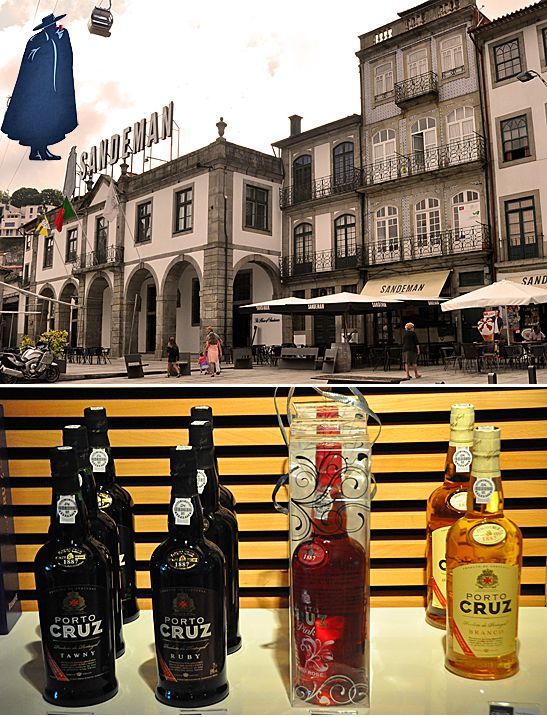
Sandeman lodge. Portocruz offerings.
We start in Gaia, on the south bank of the river where all the “lodges” are, where about 50 port wine companies compete with the legendary ones whose fame surely gives them an edge. Ferreira’s lodge is rumored to play classical music that “helps age the wine.” One of the lodges, Taylor’s, started as a sheep business and now has reputedly the most distinguished restaurant in town, the Barao de Fladgate — although we didn’t notice mutton on the menu. Sandeman, the first lodge with a logo, features a figure with a black gaucho hat, chosen because the company made sherry in Jerez in Spain. “Sandeman,” says our favorite travel writer, Rick Steves, “is the Budweiser of Port!”
We cross over Porto’s famous Luis I Bridge to the north bank of the Douro to Ribeira, the old town. The buildings are colorful. We stop by the memorial to Diocletian Monteiro, a simple boatman who died in 1996 — age 94 – still active doing what endeared him to the city, pulling drowning persons out of the river. They called him the Duke of Riverside.

Our guide and driver Manuel and the memorial to the “Duke of Riverside.” Rubeira’s old world homes.
You don’t need a car in Rubeira. You don’t want a car in Rubeira: the streets are narrow and steep and full of tourists. However, the attractions are close to each other. We start in the Sao Francisco Church, an unassuming Gothic building whose interior walls “are dripping with Baroque gold.” It has “100 kg of gold spread over everything except the floor.” Near the main door is a portrayal of how the “Saint Martyrs” were massacred by the Moors. The sculptor portrays the Moors hacking off heads gleefully but the historical facts are obscure and victims of the Spanish Inquisition might feel revenged.
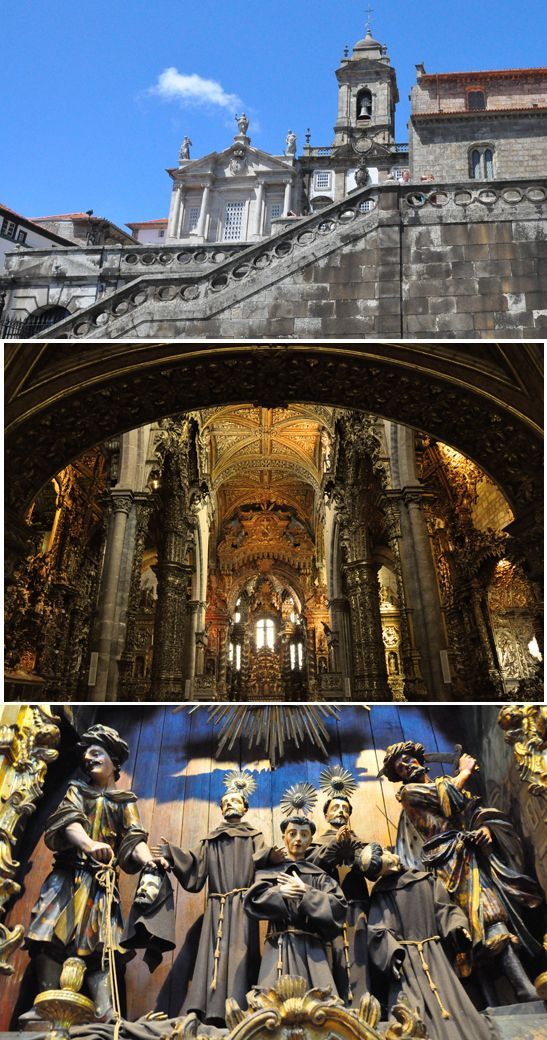
Sao Francisco Church. Church interior with 100 kg of gold on its walls. The Saints’ Massacre.
Next door some of the church’s history is on display including a sedan chair from the 19th Century. The church also has a 13th-Century attempt by an inexperienced sculptor to portray St. Francis. “He was an amateur and got the hands wrong!” says a woman walking past and speaking in accentuated English.
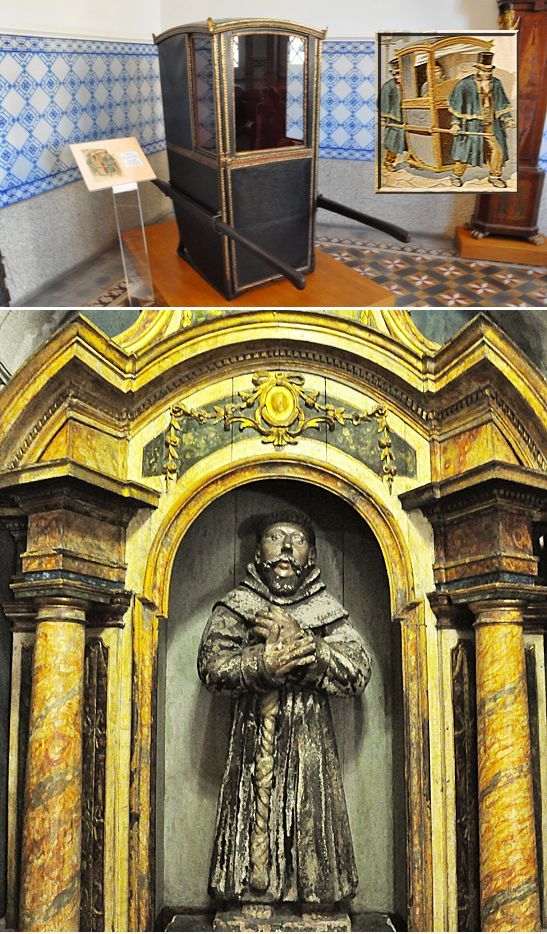
Church’s sedan chair (19th Century). Statue of St. Francis with big hands (13th Century).
Next door, replacing the Cloisters destroyed by fire, the Stock Exchange, sometimes called the Bolsa Palace, arose with its eight rooms — one, the Arabian Room, almost as gilded as the St. Francis church, its neighbor. And nearby stands the famous Lello & Irmao Bookstore. It dates back to 1906. It is truly beautiful but so famous (Lonely Planet calls it “the most beautiful library in the world” and the UK Guardian “the third best”) you barely can move. An interesting statue is nearby: Pedro I of Brazil in 1822 returned to his home in Portugal with an army to seize its throne. As Pedro IV of Portugal, he died of tuberculosis in 1834.
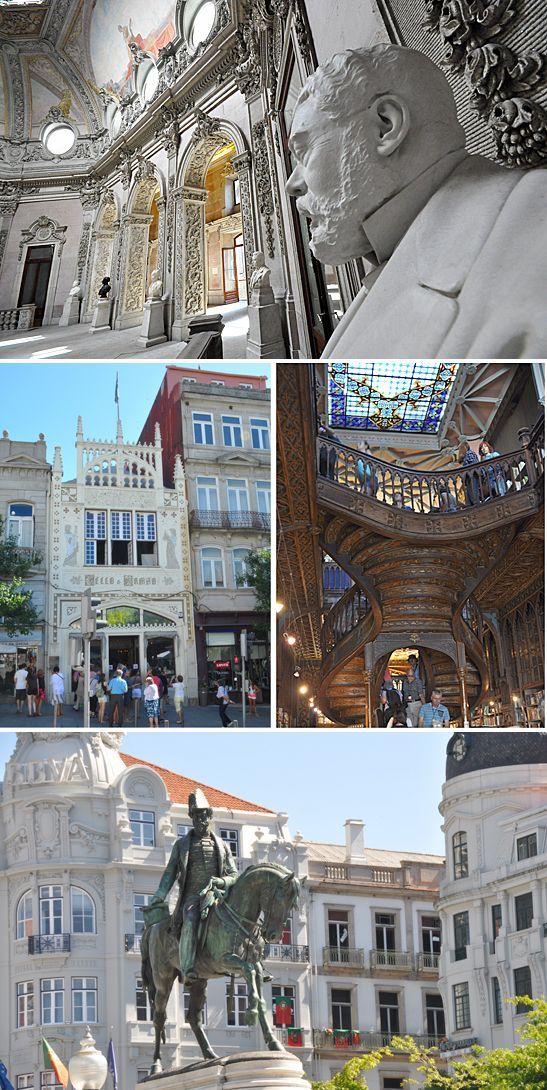
Interior Bolsa Palace. Lello & Irmao bookstore. Statue King Pedro IV
Porto, like all European cities on the Grand Tour, loves its statues.
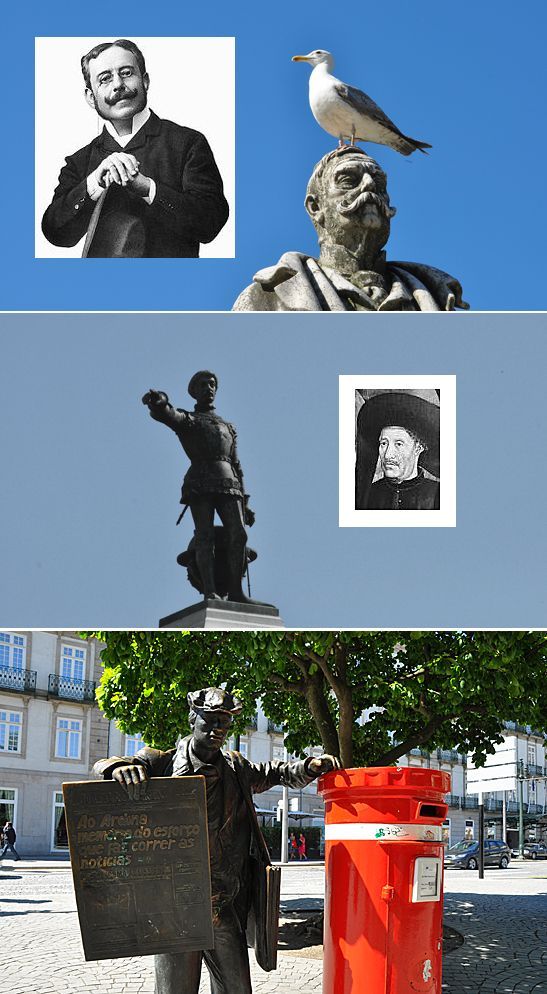
Top: The bird doesn’t care it’s perched on the head of Ramalho Ortigão, an author who cared so much for his writings he fought a duel over them. Middle: Henry the Navigator is widely seen as the person who brought Portugal into maritime history. Bottom: the ardina (newspaper seller) makes most tourists smile although many must wish they knew Portuguese so they could read the newspaper headlines.
We have gone by many of Porto’s famous places. We walk past its tall Clerigos Tower knowing it has the best view in town if you tackle 225 steps. So we pass. We are heading for something we think more beautiful: the murals, the azulejos in the waiting room of the Sao Bento train station that depict episodes in Portugal’s history. Inaugurated in 1916 at the site of a ruined 16th-Century Benedictine monastery after a Beaux-Arts architect in Porto was entrusted with the work. We stare at what Jose Marques da Silva and Jorge Colaco have achieved. It is still in use and it’s gorgeous.
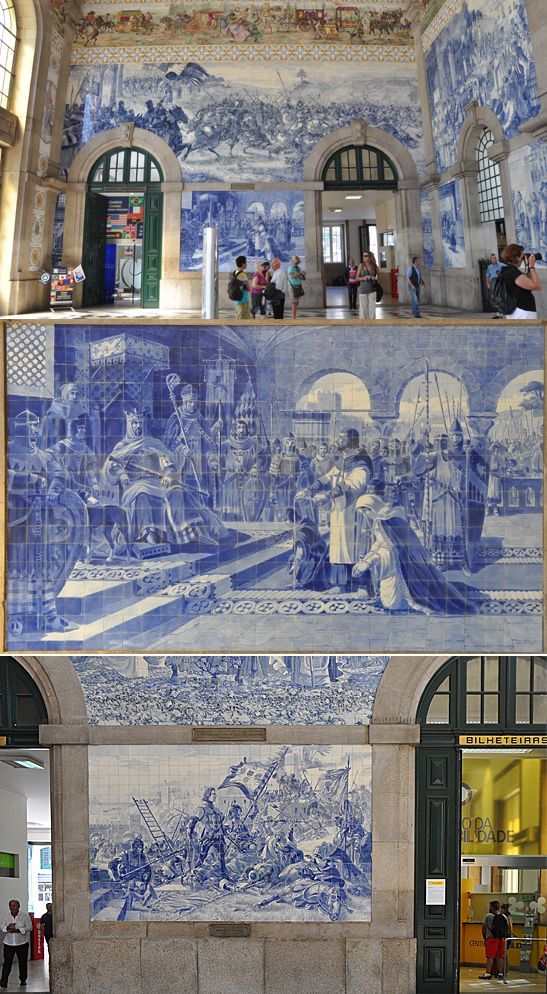
The azulejos glisten as if they were just made yesterday. There are more than 20,000 of the individual tiles and they show battles, and conquests and famous figures in Portugal’s history.
The Sao Bento station justifies its placement in any city guidebook. But just as the Lello & Irmao bookshop isn’t much fun because it’s so busy, so with the Majestic Café. It knows it’s famous but the public keeps coming and the staff seems overwhelmed. Yet it truly is an Art Nouveau beauty.
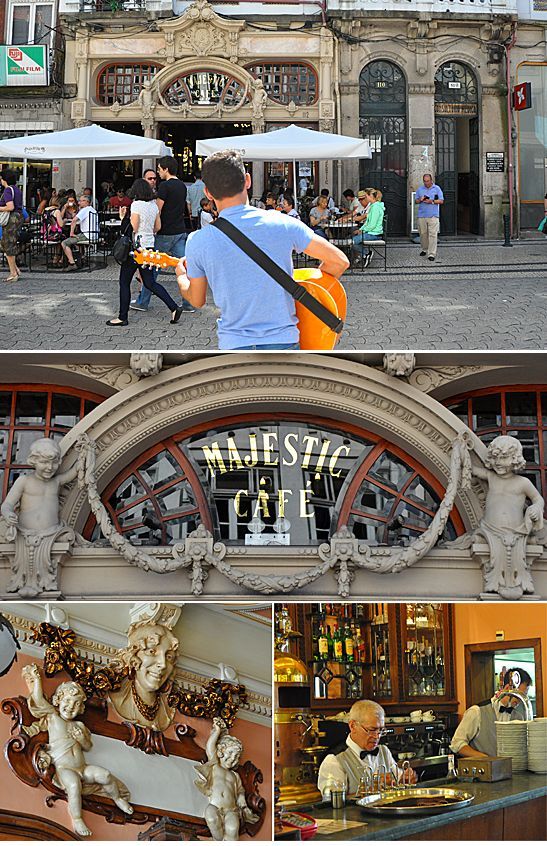
An itinerant musician plays outside Porto’s celebrated Majestic Café.
It was the end of our shore excursion. The smell of cooking in the Majestic Café had quickened our appetites and we are ready to get back to Uniworld’s Queen Isabel especially when someone shouted in the coach, “Hey! We’ll still be in time for afternoon tea!”
As our guide leaves us at the boat, she endorses our other guides’ enthusiasm and says: “Now you know why Porto has been called The Best City Break in the Nation, the Best European Destination -- and is said to have 3 of the best 10 historical buildings in the world!”

Gaia, the commercial side of Porto, the left bank.
All photography by the authors.
The Andersons, who live in San Diego, are the resident travel & cruise columnists for Physician's Money Digest. Nancy is a former nursing educator, Eric a retired MD. The one-time president of the NH Academy of Family Practice, Eric is the only physician in the Society of American Travel Writers. He has also written 5 books, the last called The Man Who Cried Orange: Stories from a Doctor's Life.




